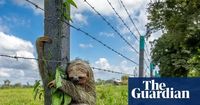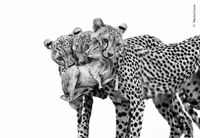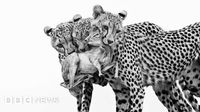The Wildlife Photographer of the Year 2025 competition has once again drawn the world’s gaze to the power and fragility of nature, capturing breathtaking moments from every corner of the globe. As anticipation builds for the announcement of the winning images on October 14, 2025, the Natural History Museum in London prepares to unveil an exhibition of the top 100 photographs, running from October 17, 2025, through July 12, 2026. Visitors will be able to explore not just the stunning visuals, but also the stories and conservation issues behind each image, thanks to insightful captions and accompanying films.
This year’s competition, according to BBC, is a testament to the patience, artistry, and tenacity of photographers who often spend weeks or months in the field for a single shot. Among the highly commended entries is a mesmerizing macro photograph by Bidyut Kalita, capturing a red potter wasp in mid-flight, clutching a green caterpillar. At first glance, the wasp appears to be riding a broomstick, but in reality, it’s carrying prey to feed its young—a reminder of the intricate food webs that sustain life.
Emmanuel Tardy from France offers a sobering look at the cost of human expansion. His image, titled "No Place Like Home," shows a brown-throated three-toed sloth clinging to a barbed wire post after crossing a road in El Tanque, San Carlos, Costa Rica. As forests are cleared and habitats fragmented, sloths are forced to make perilous ground crossings in search of the next tree, exposing them to dangers they’re ill-equipped to face. "As their habitats become fragmented due to tree loss, sloths are forced to make more ground crossings to reach the next tree, leaving them vulnerable," the exhibition notes explain.
Moving from the tropics to the polar extremes, Bertie Gregory from the UK spent two months observing an emperor penguin colony on the Ekström Ice Shelf, Atka Bay, Antarctica. His photograph, "Ice Edge Journey," captures a group of fledgling chicks teetering on the brink of an ice shelf, preparing to leap into the freezing ocean for their first attempt at feeding. Most chicks use natural ice ramps to descend safely, but this group missed the easier route. Scientists, as reported by BBC, warn that the ongoing decline in sea ice may force more penguins to breed on precarious ice shelves, making such leaps into the unknown an increasingly common—and dangerous—rite of passage.
Not all remarkable scenes involve grand, charismatic animals. Kutub Uddin, who splits his time between Bangladesh and the UK, found beauty in the miniature. His "Slime Family Portrait," taken in Slindon Wood, West Sussex, England, features a row of tiny, spherical slime moulds arranged on a fallen log, with a yellow insect egg nestled among them. Uddin described the scene as a "bizarre family portrait." Slime moulds, which are mobile, single-celled organisms, can band together to function as a single entity in search of food and reproduction—a reminder that even the smallest creatures have complex lives.
Jamie Smart from the UK captured the raw energy of the British countryside in her photograph "Rutting Call," featuring a red deer stag bellowing during the autumn rut at Bradgate Park, Leicestershire. The stag’s antlers, now fully hardened and velvet-free, regrow each spring and become more impressive each year as new points, called tines, develop. Smart, mindful of her subject’s space and safety, avoided the long grass by stretching upwards for a clear shot, demonstrating both respect and ingenuity.
In the icy wilderness of Ellesmere Island, Nunavut, Canada, Amit Eshel from Israel fulfilled a lifelong dream by photographing a pack of six Arctic wolves at eye level in -35°C. Eshel recounted how the wolves, curious due to limited human contact, came so close he could smell their breath. Arctic wolves, found only in Canada’s far north and northern Greenland, remain one of the least-studied canines, and images like Eshel’s provide rare glimpses into their world.
The exhibition doesn’t stop there. Kesshav Vikram from India waited patiently for days on the shores of Kurile Lake, Kamchatka Krai, Russia, to capture a brown bear walking with the Iliinsky volcano looming in the distance. The bear, solitary by nature, was on its way to join others for the annual salmon feast—a spectacle of abundance and survival.
Urban wildlife also finds representation. In San Francisco’s Bernal Heights Park, USA, Parham Pourahmad spent hours following a pair of coyotes, framing a striking shot where a male’s amber eye is encircled by the tail of a nearby female. Coyotes, once eradicated from the city, are now making a comeback—an example of nature’s resilience and adaptability.
Leana Kuster from Switzerland offers a playful take with "Pink Pose," showing a greater flamingo in Camargue, France, scratching its head with a long leg. The flamingo’s pink hue, she notes, comes from a diet rich in carotenoids found in algae and shrimp. Meanwhile, in Kenya’s Samburu National Park, Marina Cano captured young cheetahs practicing their hunting skills on a Günther’s dik-dik, under the watchful gaze of their mother. Cheetah cubs, hidden for their first two months, only begin to learn the art of the hunt at about a year old.
Other images carry a more somber message. Lakshitha Karunarathna from Sri Lanka documented an Asian elephant navigating a landfill in Ampara, highlighting the deadly consequences of human waste. Elephants in the region, officials say, often ingest plastic along with food scraps, which can slowly kill them. In Tanzania’s Serengeti National Park, Gabriella Comi from Italy captured a tense standoff between a lion and a cobra—nature’s drama unfolding in the harsh midday sun.
Marine and aquatic life are also celebrated. Ralph Pace from the USA waded into Monterey Bay, California, to photograph a mass of Pacific sea nettles, their translucent bells glowing amber in the green water. To protect himself from their stings, Pace coated any exposed skin with petroleum jelly, likening the sensation to a bee sting. Isaac Szabo from the USA, meanwhile, captured a female longnose gar and several males in a crystal-clear Florida river, emphasizing the importance of protecting the aquifers that sustain both wildlife and nearly half of Florida’s human population.
Jassen Todorov, also from the USA, took to the skies above San Francisco Bay to photograph the golden reflections in vast salt ponds, a landscape shaped by centuries of salt collection and now the focus of major restoration efforts. Finally, Sitaram Raul from India braved the darkness and a barrage of bat droppings to photograph fruit bats emerging from a ruined building in Banda, Maharashtra—a vivid reminder that nature often reclaims spaces humans abandon.
As the world awaits the announcement of this year’s winners, the Wildlife Photographer of the Year exhibition stands as both a celebration and a call to action. Each image tells a story—sometimes wondrous, sometimes tragic—about the delicate balance between humans and the natural world. For those who step into the exhibition at the Natural History Museum, it’s a rare chance to see through the eyes of photographers who have gone to extraordinary lengths to capture nature’s most powerful moments.






